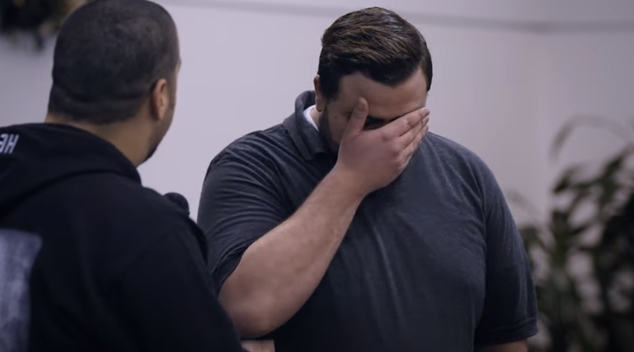Warning: If you have experienced LGBTQ+ conversion practices or religious trauma you may be triggered by the content in Pray Away.
The film’s website features some tips and resources to prioritise your mental health before, during, and after viewing the film.
Occasionally a seminal work appears that becomes a defining piece, a turning point, or breakthrough in a particular area. Considering the religious LGBTQ+ conversion movement, the documentary Pray Away, released on Netflix August 3rd, could very well be that work.
After mental health professional organisations realised that gay and lesbian people were not sick and their decades of cruel, and at time barbaric treatments, had failed, the Christian Church stepped into the space. The “ex-gay” movement, later to become more commonly known as “conversion therapy”, was born.
In the early 70s, fueled by the Jesus Revolution, the Charismatic Movement, and modern translations of the Bible, individual but unconnected “ministries” sprung up like mushrooms in the US and other parts of the world, including Australia.
As Michael Bussee, a pioneer of the movement, tells us in the documentary, some of the US groups came together in 1976 and founded Exodus.
Exodus grew to become the umbrella organisation with 100s of affiliate ministries globally. At its height, president Alan Chambers, who also appears in the documentary, claimed that Exodus International, received over 400,000 inquiries each year from people wanting to turn straight and that hundreds of thousands actually had.
In less than a decade Alan would not only be admitting publicly it was a lie and that 99.9% of the people he knew had not changed orientation but also apologising for the harm and deaths caused by those lies and the organisation. This process is also explored in the documentary. Exodus closed its doors in 2013.
Previous leaders and spokespeople for the “change is possible” movement and organisations, John Paulk, Yvette Cantu Schneider, Randy Thomas, and Julie Rogers, all have a story to tell. There are uncomfortable and sometimes chilling moments as they talk about their involvement, regrets and moments of awakening.
Archival footage is shown of now deceased “ex-gay” “ex-trans” advocates Joseph Nicolosi and Sy Rogers (not related to Julie) who some will be familiar with. Current proponents Anne Paulk from Restored Hope Network and Ricky Chelette from Living Hope Ministries refused to be interviewed. Considering Julie Rogers claims of manipulation by Chelette while she was a part of Living Hope, his unwillingness to go on camera is understandable.
To think that this documentary is just about a series of historical events would be a huge mistake. It is still happening now, and new groups have started up.
In every non-affirming evangelical, Pentecostal and some mainstream churches young LGBTQ+ people are going through the same emotional, psychological and spiritual torment many of us endured for decades. Within some cultures and countries today the pressure to conform to a heterosexual norm is enormous, even life threatening. Exorcisms to cast out homosexual demons still occurs in Christian and Islamic circles.
One thing that isn’t explored in the documentary is the intermediary step Randy and Julie took on their journeys. When I spent time with them at the final Exodus Conference in 2013, they had both moved to the “it’s okay for me to be gay, but I can never act on it” space. They were looking at a celibate future. Falling in love changed that. In some circles there has been a movement away from “change is possible” to a celibacy model e.g. Sydney Diocese Anglicans.
The celibacy model however is still based on the same outdated belief that was the foundation of the conversion “therapy” movement. That is, the belief that any deviation from a heterosexual orientation or binary gender model is sin and a sign of brokenness. It took Exodus four decades to realise they were wrong and the harm they had caused. God, I hope it doesn’t take that long for the celibacy movement to wake up.
The above does not detract from the content of the documentary. Pray Away is chock full of excellent and powerful material. The only reason you’d turn it off is to give yourself a break from the highly emotional content.
Director/producer Kristine Stolakis and her team are to be highly commended for their well-thought out and constructed documentary.
Let’s hope and pray that the documentary will go way beyond the viewing of the LGBTQ+ people and allies and be the catalyst for change, so desperately needed, in conservative churches and denominations and in the lives of religious leaders and parents.
Pray Away is a must see, must share documentary.
Anthony Venn-Brown
Anthony is the author of the bestseller A Life of Unlearning – a preacher’s struggle with his homosexuality, church and faith, and the founder and CEO of Ambassadors & Bridge Builders International (ABBI).
Anthony was one of the first in the world to experience conversion ideology in a Christian context. He is a survivor.
Since 2000, Anthony has worked with over 4,000 conversion practice survivors, and many more experiencing faith/sexuality/gender conflicts.
He was a contributor to the dialogue Julie Rogers mentions in the documentary and one of two gay people invited by Alan Chambers to attend the final Exodus conference in 2013.
You can support our work by subscribing to our Patreon
or contributing to our GoFundMe campaign.







